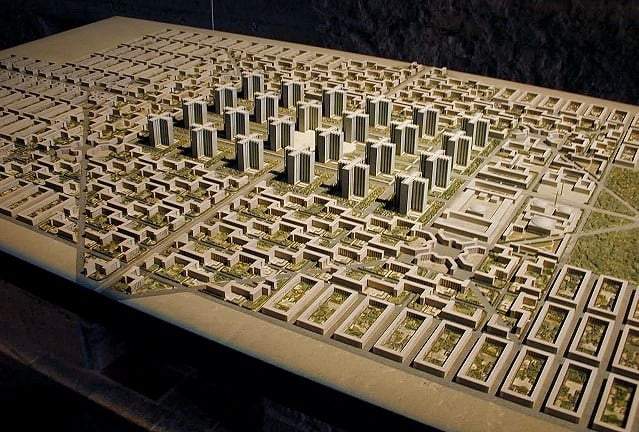ATLAS pavilion and exhibition trace vilnius city’s 700th anniversary in lithuania
atlas pavilion – vilnius 200 years ago in lithuania
In the Spring of 2023, young Lithuanian architect duo Dalia Puodziute Seniuniene and Julius Seniunas built a pavilion titled ATLAS – Vilnius 200 years ago to celebrate Vilnius city’s 700th anniversary. The project was selected by the Lithuanian National Museum, as part of an open call to design a temporary and open exhibition space dispersed in the New Arsenal park facing the museum and Gediminas Castle hill, all tucked within a UNESCO heritage old town of Vilnius. The temporary pavilion hosts a never-seen-before model of Vilnius city, meticulously recreated from recently discovered historical maps and drawings from the museum‘s archives.
all images © Gabija Strockytė
an open-air experience scattered across a UNESCO site
Forming a strict grid of sixteen objects scattered across the New Arsenal park, the ATLAS Pavilion intersects with the existing landscape system and historical artifacts within the archeological context, creating different layers of mediums for visitors to uncover throughout the exhibition. Amphitheater, Triptych, Rotonda, Walls, Forum, Flags, Stage, Info stands, etc., all serving as ‘information carriers in an open-air museum, unified by the historical color of Vilnius old town as seen from above, imprinting the celebration of its 700th anniversary. It became not only the pavilion in a city but rather a city in a pavilion,’ share Dalia Puodziute Seniuniene and Julius Seniunas.
the ATLAS Pavilion and exhibition scattered across New Arsenal Park
a scattered & layered design that celebrates vilnius’ 700th
The architect duo complements the 3D printed model of the Vilnius city with ambient sound as well as historical narratives and video projections on all four walls of the pavilion. Meanwhile, a Rotonda holds a historical map of Vilnius city printed on the inside of a curtain flowing in the wind. A simple, yet curious organization of the objects reacting to different park objects and backdrops, activates the area. The scattered elements could be approached differently from different sides, creating many narratives and leaving space for visitors to explore the showcase on their own. Considering the sensitive heritage context, the architects have decided to not interfere with the archeological layers of the ground — instead, emphasizing the importance of the Vilnius locale by using above-ground foundations that double as public benches for the ATLAS Pavilion exhibition. All foundations/benches are cast in concrete following the same grid, while the Amphitheater’s concrete benches are used to stabilize the overall construction, calculated by the lifting forces of the pyramid tent roof.
adaptive reuse meets industrial materials at ATLAS PAVILION
Transparent steel gratings and slender tubes powder coated in beige red color are the main structural carriers, subtly blending into the context and not covering the historical facade of the Lithuanian National Museum or the monumental King Mindaugas sculpture in the park. Kinetic elements such as the aluminum doors of the Amphitheater, the outside surface of the expositional curtain, and perforated flags emerge as reflective objects, subtly blending in the green surroundings. The duo chose white for the temporary tent roofs and black for technical objects — including sound, lighting, and visual system installations in the main objects as well as technical attachment systems of the exhibition material. ‘The typology of a temporary pavilion always raises an essential question on how this structure could be reused. From the very start, it was designed in a way to be easily assembled, stored compactly, and smoothly reassembled in another situation. This enables the diversity of objects to create an ever-changing formula generating new scenarios in alternative contexts and is adaptive to the different purposes/locations/aspirations,‘ conclude the architects.
using above-ground foundations as public benches
Lithuanian National Museum entrance
3D-printed Vilnius model supported with ambient sound and video projections
Rotonda curtain printed with historical map and long-gone professions of Vilnius city
the curtain subtly blends with the park’s green surroundings



